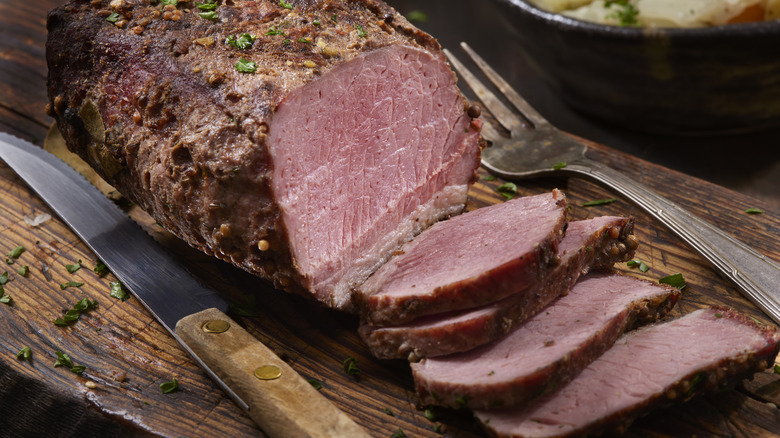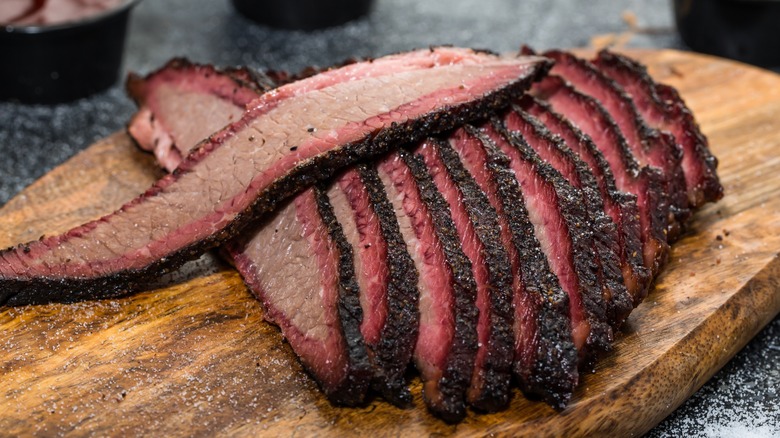Beef Brisket Vs Corned Beef: What's The Big Difference?
Beef brisket and corned beef can be related, but they're not the same. The main similarity between them is that they can share the same beginnings — both sourced from the lower chest of the cow — but that's about it. Brisket is the slow-cooked star of American-style barbecue, often smoked for up to 16 hours until it reaches melt-in-your-mouth tenderness. Corned beef, on the other hand, is brined and salt-cured, usually found piled high in a Reuben sandwich (not to be confused with its cousin, the Rachel) or served as part of a hearty St. Patrick's Day feast.
To delve deeper into the differences between beef brisket and corned beef, Food Republic consulted Christie Vanover, champion pitmaster and owner of Girls Can Grill. Part of the confusion comes down to language: Brisket refers to a raw cut of beef, while corned beef describes a very specific preparation method. According to Vanover, "beef brisket is a particular cut on the cow," while "creating corned beef involves soaking the beef in brine for several days with pickling spices and curing salt."
The curing process not only changes the meat's flavor profile, but also its color, giving it its familiar pinkish hue. Smoked brisket, meanwhile, retains its natural beefy flavor, enhanced by the slow infusion of high-quality wood smoke. So while they may start from the same place, brisket and corned beef end up as two very different dishes, each with its own cooking techniques and traditions.
What is beef brisket?
Beef brisket is one of the nine primal cuts of beef, taken from the breast or chest of the cow. This part of the animal is a hardworking muscle that supports much of the cow's weight, which is why it's known for its toughness — a result of dense intramuscular connective tissue. While brisket is one of those meats you should never grill — as it's not suited to quick-cooking methods — its connective tissue is what makes it so tender when cooked slowly. "When you season it with salt and pepper or other spices, it can be cooked a variety of ways, including in the oven, smoker, or even boiled," Christie Vanover says. Low and slow methods are what make beef brisket truly shine.
Vanover considers smoking the best method for cooking brisket "because the smoke flavor enhances the beefiness." There are many ways to do this, but she notes that she prefers "the Texas Crutch, which is when you wrap the brisket in foil or butcher paper once it reaches [150 to 170 degrees Fahrenheit] internal temperature. This helps speed up the cook and locks in moisture."
Brisket can be tricky to perfect, as it's made up of two muscles — the point and the flat — which cook at different rates. Locking in moisture can mean the difference between a moist, flavorful dish and one that's tough and dry.
What is corned beef?
According to Christie Vanover, "corned beef can be made from any cut of beef. Brisket is a common option, but so is beef navel." So while brisket is often used for corned beef, they're not mutually exclusive. Corned beef is preserved for weeks using a salt-brining process, with the word "corned" originating from the large grains of rock salt traditionally used. This process infuses the meat with a distinctly savory flavor profile. While smoked brisket is typically seasoned with salt and pepper before cooking, corned beef is cured with a mix of pickling spices such as peppercorns, mustard seeds, coriander seeds, bay leaves, and cloves, which contribute to its rich and aromatic taste.
After brining, corned beef can be sold raw or pre-cooked. "If it's cooked in an oven or boiled, it's called corned beef. If instead it's smoked, that's when it becomes pastrami," Vanover explains. Smoking corned beef as you would a brisket transforms it into an entirely different delicacy, with its own rich history and flavor profile. Traditionally, though, corned beef is boiled or simmered until tender, a result of the slow, moist-heat cooking method. This results in the melt-in-your-mouth texture that's perfect for a St. Patrick's Day feast with cabbage and potatoes, or paired with Swiss cheese and sauerkraut in a Reuben sandwich, where its salty flavor takes center stage.



